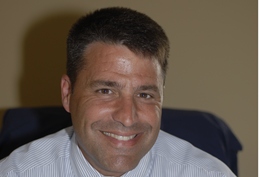Drag Racing IS Entertainment: Perspective by Bill Bader Jr.
Courtesy of Pro Sportsman Association
Norwalk, OH – Bill Bader Jr., son of legendary race promoter and former IHRA President Bill Bader, runs Summit Motorsports Park in Norwalk, Ohio, home to an NHRA national event, a regional/divisional race, and as many major independent shows as any track in the country. Bader Jr. is as smooth as they come, all business, and a total pro – just like his dad.
independent shows as any track in the country. Bader Jr. is as smooth as they come, all business, and a total pro – just like his dad.
“Summit Racing Equipment NHRA Nationals” rolls off his tongue faster than most people could say “Norwalk,” his track workers aren’t track workers – they’re “team members” – and this weekend’s Division 3 Lucas Oil Series event isn’t a points meet; it’s the B’laster Cavalcade of Stars presented by Budweiser. The Pro Sportsman Association’s Todd Veney caught up with Bader Jr., 44, to get his thoughts on what it takes to make a racetrack work, why he switched from IHRA to NHRA, and how he drew a turn-away crowd for a divisional race.
PSA: How did you get 48,000 people to a divisional race?
BBJ: By not looking at it as a divisional race. I looked at it as a national event. When we had our IHRA national events here, we didn’t have John Force, Tony Schumacher, or Larry Dixon. Our biggest star was probably Mark Thomas – an Alcohol Funny Car racer – and I applied the same formula that made our IHRA national event a success to our divisional race. I looked into the old Coca-Cola Cavalcade of Stars name, saw that the trademark had expired, and registered it. I own the name. We made the Alcohol Dragster drivers our Top Fuel stars, and our Alcohol Funny Cars became our fuel Funny Cars. Some alcohol racers feel like they’re second-class citizens, and I had a meeting with them in 2008 and told them that we were going to pack this place for the divisional. I saw the looks on their faces, but I told them, “Trust me. It may not happen this year or next year, but it will happen.” And in 2010, it did. We literally had to close the gates and turn people away.
PSA: So you see your events as entertainment – not as simply races…
BBJ: Drag racing is entertainment. What’s wrong with saying you’re in the entertainment business? It’s not like we’re manipulating the outcome. We’re entertaining people. We learned with our Night Under Fire event [where big-name nitro Funny Car racers, including Force himself, fill the stands for a one-day extravaganza] that you have to market each event differently. The fan who comes to the Summit Racing Equipment NHRA Nationals is not necessarily the same person who comes to the Night Under Fire. People who go to an NHRA national event typically are hardcore fans from major metro markets. The Night of Fire fan is more likely to be from someplace rural. He doesn’t know everything about every car, and it’s probably the only race he’s going to go to all year. He just wants a good show, and he’s going to get one.
PSA: What’s the best way to promote a drag race?
BBJ: First, you have to understand who your fan is. We have all kinds of events, but 10 or 12 are significant events with their own unique footprint in the market, and each one needs a different marketing strategy. It’s my job to sell tickets. It’s not NHRA’s job – they’re a sanctioning body. What we’ve always tried to do is sell the entire experience. You can’t just do one-week radio buys on WMMS in Cleveland and WIOT in Toledo anymore. It’s not the same world it was 30 years ago. It’s not the same world it was in 2008, when everything turned upside down. People have scaled down their lifestyles in the last four years; they’ve learned to live within their means. For the Summit Racing Equipment NHRA Nationals, we’re using 18 different marketing channels. We look at this place as a destination venue – like Disneyland. That’s why we’ve laid claim to the July 4th weekend. Everyone in the United States is looking for something to do that weekend. Why do the same old mundane thing you’ve always done in the past just because that’s what you’ve always done? Why go to the lake? Come to Norwalk, Ohio! The hardcore fans already know the race is that weekend – we want to get everybody else there. The commercial we’re doing for that event doesn’t look, taste, or feel like any drag racing TV ad ever. Nobody’s screaming, nobody’s crashing, and nobody’s holding a Wally. It’s designed to change human behavior.
PSA: Whose idea was it to switch from IHRA to NHRA – yours or your dad’s?
BBJ: Mine. Dad bought the track in 1974. He already ran Sandusky Speedway – he was a round-track racer – and the first drag race at his track was the first drag race he’d ever been to. He always hounded Bob Daniels, the old Division 3 Director, to get a national event. He just wanted one in the worst way, but Bob told him flat-out, “You’ll never have an NHRA national event in Norwalk – we’ve already got Indy and Columbus,” so he reached out to Ted Jones and Larry Carrier to get an IHRA race and tried to make that the best it could be. We’d have this place packed for Saturday nights, but on Sundays there’d be 3,000 people in the stands. It was heartbreaking. When Dad stepped down from IHRA in 2004, I looked into the future, and our future was NHRA. I made a call to Tom Compton, and it started a two-year dialogue. Tom called Dad one day – I think it was more of a courtesy call than anything else – and told him that he’d already been talking with me for a couple of years about having an NHRA national event. Dad called me right up and said, “Are you crazy?” He was the president of IHRA and he had no idea that I’d been talking to Tom. That first year, 2007, when the first pair of Top Fuel cars fired up Sunday morning and the stands were full, we just looked at each other. That was a moment. It wasn’t about how much money we were going to put in the bank; it was about a dream realized.
PSA: Was the plan always for you to take over for him?
BBJ: Well, I’ve been working here since I was 10 years old. My parents were divorced, my father was a workaholic, I wanted to have a relationship with him, and by coming to work here I kind of met him on his terms. I started out picking up garbage, and I’ve installed guardrails, done minor electrical stuff, put up fences, worked on drainage, and just basically done every job there is. My degree is in accounting and corporate finance, but I’m more of a marketer than a bean counter. This is not a business you can run with a pencil.
PSA: What did you learn from Bill Sr.?
BBJ: He always said, if the customer wins, you can’t lose. I’ve seen him in bad situations, and when it’s over, everybody comes out laughing, arm-in-arm. I definitely haven’t mastered the art like he has, but we have an incredible rapport with our fans – they’re our guests, always – and with guys racing in, say, the DOT Tire class, or the Alcohol Funny Car racers here for the divisional race, or the local guys who are out here every weekend. This track is my home. I spend a lot more time in my office than I do at home. The Bader family isn’t the Angel family or the Meyer family, who had other businesses before they owned a track. This is all we do. This is how my sons are going to college. It’s who we are and it has to work.
PSA: What’s been most surprising?
BBJ: Just how hard this really is. It has to be one of the most difficult ways in the world to make a living. This business will eat you up and spit you and not even care, and you have to be mentally tough like my dad. People come to one of our major events, see 30,000 people in the stands, and think they’re looking at 100,000. The human mind overestimates the size of the crowd and underestimates the expense and risk involved with putting on an event like that. That’s why all these people think they want to get in this crazy business. Hundred-hour workweeks are not uncommon, and it’s not just me. The people who work here are dedicated, drank the Kool-Aid, and bought in to what we’re trying to do.
PSA: What would you do to improve drag racing as a whole?
BBJ: Our sport has a problem: kids don’t have the passion for the automobile that they once did. Lots of them aren’t even interested in getting a driver’s license. We need to get mainstream America more excited about drag racing, get people emotionally involved. I don’t think the human-interest side of the sport is exploited nearly enough. Most top-end interviews are uninspiring. Racers have become homogenized – there’s no color, no personality. Everyone’s afraid of irritating their sponsors. Where’s the subplot? What are the real storylines? Don’t talk about which lane is better. Who cares? Drag racing is a fast, ultra-exciting, consumable product. Every time you turn around, somebody just won. There’s a problem, and we, as an industry, need to figure it out. One thing about me – and it’s a blessing or a curse, depending on who you ask – is that I’m never satisfied with anything. Ever. Every night when I drive out of here, I think there must be something I could have done better.


